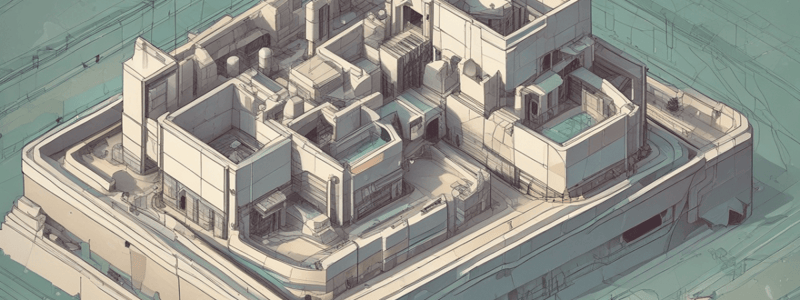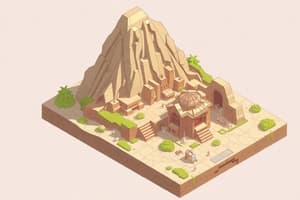Podcast
Questions and Answers
What is the angle at which the length and depth lines are drawn from the ground line in an isometric drawing?
What is the angle at which the length and depth lines are drawn from the ground line in an isometric drawing?
- 45o
- 60o
- 90o
- 30o (correct)
What is the purpose of using isometric grid paper when drawing a 3D object?
What is the purpose of using isometric grid paper when drawing a 3D object?
- To create a decorative border
- To accurately draw the object's dimensions (correct)
- To create a 2D representation of the object
- To create a realistic perspective
What should be written in the bottom right corner of the grid paper in all capital letters?
What should be written in the bottom right corner of the grid paper in all capital letters?
- Name and Surname (correct)
- Object and Dimensions
- Title and Description
- Date and Time
What is the first step in drawing a 3D isometric drawing of a cube?
What is the first step in drawing a 3D isometric drawing of a cube?
What is the purpose of the construction box in drawing a 3D isometric drawing of a cube?
What is the purpose of the construction box in drawing a 3D isometric drawing of a cube?
What should be done when drawing the shapes of the object on the surface of the box?
What should be done when drawing the shapes of the object on the surface of the box?
What is the purpose of using construction lines in drawing a 3D isometric drawing of a cube?
What is the purpose of using construction lines in drawing a 3D isometric drawing of a cube?
What should be done before drawing the cube on the isometric grid paper?
What should be done before drawing the cube on the isometric grid paper?
What is the primary purpose of Step 5 in creating an orthographic drawing?
What is the primary purpose of Step 5 in creating an orthographic drawing?
What type of graph paper is used for drawing orthographic projections?
What type of graph paper is used for drawing orthographic projections?
What is the main difference between First Angle and Third Angle Orthographic Projection Layouts?
What is the main difference between First Angle and Third Angle Orthographic Projection Layouts?
What is the purpose of the conventions line in an orthographic drawing?
What is the purpose of the conventions line in an orthographic drawing?
What is the primary use of the First Angle Orthographic drawing information notes?
What is the primary use of the First Angle Orthographic drawing information notes?
What is the purpose of the video icon in the context of orthographic drawings?
What is the purpose of the video icon in the context of orthographic drawings?
What is the main characteristic of an orthographic projection?
What is the main characteristic of an orthographic projection?
What is the purpose of the content icon in the context of orthographic drawings?
What is the purpose of the content icon in the context of orthographic drawings?
Flashcards are hidden until you start studying
Study Notes
Isometric Drawings
- An isometric drawing is a simple way to draw a 3D object from an angle, with length and depth lines at 30° from the ground line and height at 90°.
- Isometric grid paper is used to draw isometric drawings.
- To draw an isometric cube:
- Step 1: Write the title block (name and surname) in capital letters on the bottom right corner of the grid paper.
- Step 2: Determine the starting point on the graph page, usually close to the bottom and center.
- Step 3: Determine the total dimensions of the object using orthographic or isometric projection, and draw a construction box.
- Step 4: Lightly draw the shapes of the object on the surface of the box, starting from the side view.
- Step 5: Darken the outlines of the shapes and add non-isometric lines if needed.
Orthographic Drawings
- Orthographic projections can be drawn on graph paper with blocks.
- There are two types of orthographic projections: First Angle and Third Angle.
- Downloadable resources:
- Orthographic graph paper
- First Angle Orthographic drawing information notes
- Third Angle Orthographic drawing information notes
Drawing Conventions
- Line conventions are used in drawings to represent different components.
- Examples of line conventions include:
- Continuous thick lines for visible outlines
- Continuous thin lines for hidden outlines
- Dashed lines for centerlines
- Chain lines for Cutting Plane lines
Studying That Suits You
Use AI to generate personalized quizzes and flashcards to suit your learning preferences.




